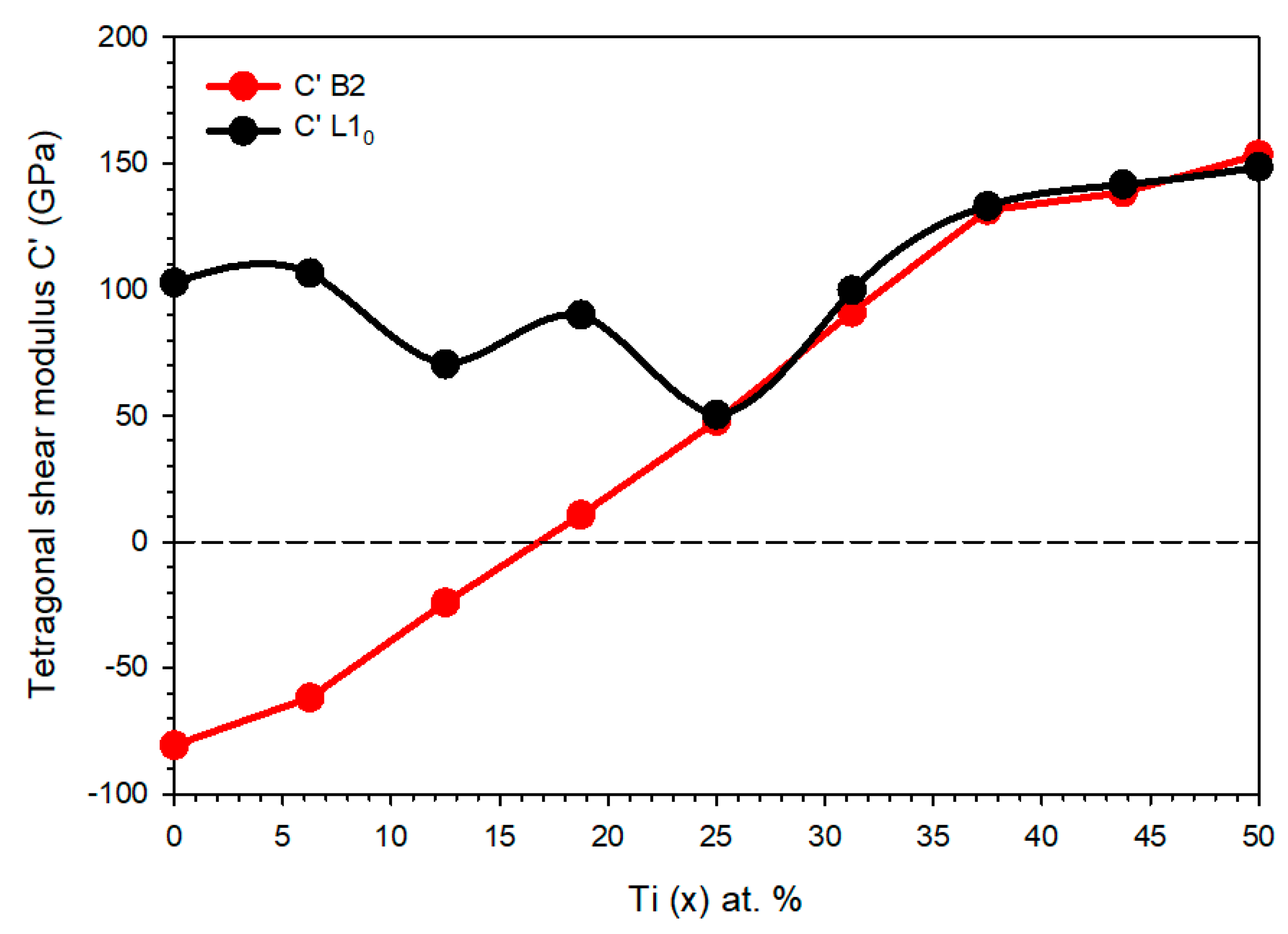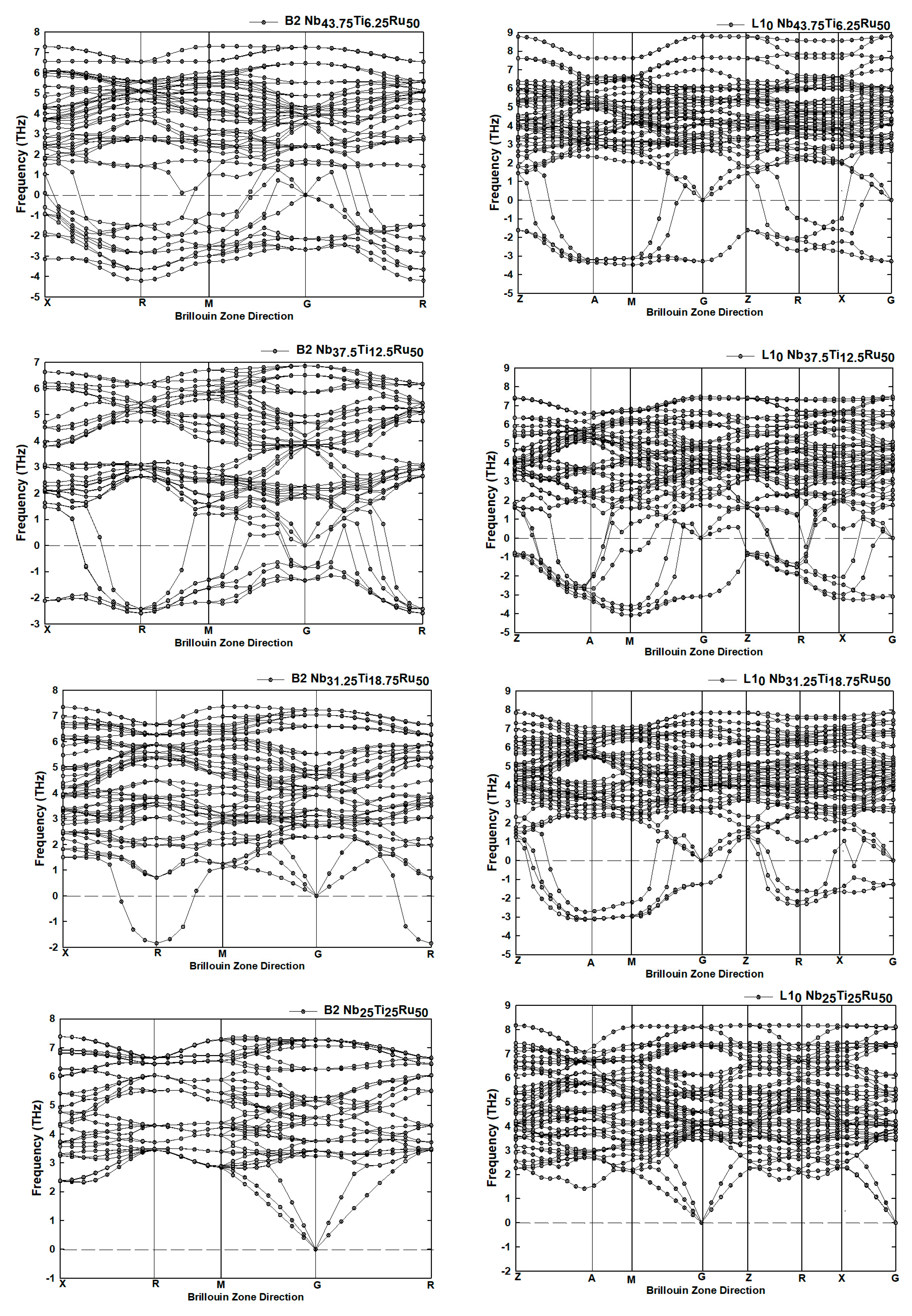First-Principle Study on Tailoring the Martensitic Transformation of B2 Nb50−xTixRu50 Shape-Memory Alloy for Structural Applications
Abstract
1. Introduction
2. Materials and Methods
3. Results and Discussion
3.1. Lattice Parameters
3.2. Thermodynamic Stability
3.3. Elastic Properties
3.4. Electronic Properties
3.5. Lattice Dynamics
4. Potential Applications of Ti Containing NbRu Alloys
5. Conclusions
Author Contributions
Funding
Data Availability Statement
Conflicts of Interest
References
- Fonda, R.; Jones, H.; Vandermeer, R. The shape memory effect in equiatomic TaRu and NbRu alloys. Scr. Mater. 1998, 39, 1031–1037. [Google Scholar] [CrossRef]
- Cai, W.; Zheng, Y.F.; Meng, X.; Zhao, L.C. Superelasticity in TiNi Alloys and Its Applications in Smart Systems. Mater. Sci. Forum 2005, 475–479, 1915–1920. [Google Scholar] [CrossRef]
- Otsuka, K.; Ren, X. Physical metallurgy of Ti–Ni-based shape memory alloys. Prog. Mater. Sci. 2005, 50, 511–678. [Google Scholar] [CrossRef]
- Huang, X.; Ackland, G.J.; Rabe, K.M. Crystal structures and shape-memory behaviour of NiTi. Nat. Mater. 2003, 2, 307–311. [Google Scholar] [CrossRef] [PubMed]
- Ye, Y.Y.; Chan, C.T.; Ho, K.M. Structural and electronic properties of the martensitic alloys TiNi, TiPd, and TiPt. Phys. Rev. B 1997, 56, 3678–3689. [Google Scholar] [CrossRef]
- Firstov, G.S.; Kosorukova, T.A.; Koval, Y.N.; Verhovlyuk, P.A. Directions for High-Temperature Shape Memory Alloys’ Improvement: Straight Way to High-Entropy Materials? Shape Mem. Superelasticity 2015, 1, 400–407. [Google Scholar] [CrossRef]
- Tan, C.; Cai, W.; Tian, X. Structural, electronic and elastic properties of NbRu high-temperature shape memory alloys. Scr. Mater. 2007, 56, 625–628. [Google Scholar] [CrossRef]
- Manzoni, A.; Chastaing, K.; Denquin, A.; Vermaut, P.; Portier, R. Phase transformation and shape memory effect in Ru-based high temperature shape memory alloys. Solid State Phenom. 2011, 172–174, 43–48. [Google Scholar] [CrossRef]
- Chastaing, K.; Denquin, A.; Portier, R.; Vermaut, P. High-temperature shape memory alloys based on the RuNb system. Mater. Sci. Eng. A 2008, 481–482, 702–706. [Google Scholar] [CrossRef]
- Chang-Long, T.; Wei, C.; Xiao-Hua, T. Combined experimental and theoretical study on the effect of Nb content on martensitic transformation of NbRu shape memory alloys. Chin. Phys. B 2010, 19, 430–435. [Google Scholar] [CrossRef]
- Chang-Long, T.; Xiao-Hua, T.; Wei, C. Effect of Fe on martensitic transformation of NbRu high-temperature shape memory alloys: Experimental and theoretical study. Chin. Phys. Lett. 2008, 25, 3372–3374. [Google Scholar] [CrossRef]
- Benarchid, M.; David, N.; Fiorani, J.-M.; Vilasi, M.; Benlaharche, T. Enthalpies of formation of Nb–Ru and Nb–Ru–Al alloys. Thermochim. Acta 2009, 482, 39–41. [Google Scholar] [CrossRef]
- Ju, J.; Liu, H.; Shuai, L.; Liu, Z.; Kang, Y.; Yan, C.; Li, H. Martensite Transformation and mechanical properties of polycrystalline Co-Ni-Al alloys with Gd doping. Metals 2018, 8, 848. [Google Scholar] [CrossRef]
- Li, Y.; Xin, Y.; Chai, L.; Ma, Y.; Xu, H. Microstructures and shape memory characteristics of dual-phase Co–Ni–Ga high-temperature shape memory alloys. Acta Mater. 2010, 58, 3655–3663. [Google Scholar] [CrossRef]
- Wu, Y.; Wang, J.; Jiang, C.; Xu, H. Martensitic transformation, shape memory effect and mechanical properties of dual-phase Ni50−xTbxMn30Ga20 (x = 0–1) alloys. Mater. Sci. Eng. A 2015, 646, 288–293. [Google Scholar] [CrossRef]
- Zhou, L.; Mehta, A.; Giri, A.; Cho, K.; Sohn, Y. Martensitic transformation and mechanical properties of Ni49+xMn36–xIn15 (x = 0, 0.5, 1.0, 1.5 and 2.0) alloys. Mater. Sci. Eng. A 2015, 646, 57–65. [Google Scholar] [CrossRef]
- Hayakawa, M.; Inoue, Y.; Oka, M.; Nakagawa, H. Martensitic Transformation and Mechanical Properties of (Y, Ce)-Tetragonal Zirconia Polycrystals. Mater. Trans. JIM 1995, 36, 729–734. [Google Scholar] [CrossRef]
- Nkomo, D.; Khodja, M.; Moller, H.; Phasha, M. The effect of systematic substitution of Nb with Ti on a potential high-temperature shape memory alloy: B2 NbRu. MATEC Web Conf. 2023, 388, 07018. [Google Scholar] [CrossRef]
- Clark, S.J.; Segall, M.D.; Pickard, C.J.; Hasnip, P.J.; Probert, M.I.J.; Refson, K.; Payne, M.C. First principles methods using CASTEP. Z. Kristallogr. 2005, 220, 567–570. [Google Scholar] [CrossRef]
- Vanderbilt, D. Soft self-consistent pseudopotentials in a generalized eigenvalue formalism. Phys. Rev. B 1990, 41, 7892–7895. [Google Scholar] [CrossRef]
- Perdew, J.P.; Wang, Y. Accurate and simple analytic representation of the electron-gas correlation energy. Phys. Rev. B 1992, 45, 13244. [Google Scholar] [CrossRef] [PubMed]
- Perdew, J.P.; Burke, K.; Ernzerhof, M. Generalized gradient approximation made simple. Phys. Rev. Lett. 1996, 77, 3865–3868. [Google Scholar] [CrossRef] [PubMed]
- Hadi, M.A.; Christopoulos, S.-R.G.; Chroneos, A.; Naqib, S.H.; Islam, A.K.M.A. DFT insights into the electronic structure, mechanical behaviour, lattice dynamics and defect processes in the first Sc-based MAX phase Sc2SnC. Sci. Rep. 2022, 12, 14037. [Google Scholar] [CrossRef] [PubMed]
- Shapiro, S.M.; Xu, G.; Gu, G.; Gardner, J.; Fonda, R.W. Lattice dynamics of the high temperature shape memory alloy Nb-Ru. Phys. Rev. B 2006, 73, 214114. [Google Scholar] [CrossRef]
- Chen, W.; Yuan, R.; Tan, F.; Xu, W. First-principles determination of the crystallography of the low-temperature phase for NbRu and TaRu shape memory alloys. Phys. Chem. Chem. Phys. 2022, 24, 22599–22604. [Google Scholar] [CrossRef] [PubMed]
- Nkomo, D.; Ngobe, B.; Phasha, M.; Yamabe-Mitarai, Y. The SCF convergence criteria of the ab initio calculations of elastic properties of single-crystal B2 ZrPd phase. Mater. Today Proc. 2023, in press. [Google Scholar] [CrossRef]
- Mousa, A.A.; Hamad, B.A.; Khalifeh, J.M. Structure, electronic and elastic properties of the NbRu shape memory alloys. Eur. Phys. J. B 2009, 72, 575–581. [Google Scholar] [CrossRef]
- Grimvall, G.; Magyari-Köpe, B.; Ozoliņš, V.; Persson, K.A. Lattice instabilities in metallic elements. Rev. Mod. Phys. 2012, 84, 945–986. [Google Scholar] [CrossRef]
- Chen, X.-Q.; Fu, C.; Morris, J.R. The electronic, elastic, and structural properties of Ti–Pd intermetallics and associated hydrides from first principles calculations. Intermetallics 2010, 18, 998–1006. [Google Scholar] [CrossRef]
- Duffy, K.P.; Padula, S.A., II; Scheiman, D.A. Damping of high-temperature shape memory alloys. Behav. Mech. Multifunct. Compos. Mater. 2008, 6929, 69291C. [Google Scholar] [CrossRef]
- Padula, S.; Bigelow, G.; Noebe, R.; Gaydosh, D.; Garg, A. Challenges and progress in the development of high-temperature shape memory alloys based on nitix compositions for high-force actuator applications. In Proceedings of the SMST-2006—International Conference on Shape Memory and Superelastic Technologies, Pacific Grove, CA, USA, 7–11 May 2006; pp. 787–802. [Google Scholar] [CrossRef]
- Wu, Z.; Benafan, O.; Lawson, J.W. A first-principles study of the phase transitions in ultrahigh temperature shape memory alloy RuNb. Acta Mater. 2024, 276, 120140. [Google Scholar] [CrossRef]
- Krooß, P.; Niendorf, T.; Kadletz, P.M.; Somsen, C.; Gutmann, M.J.; Chumlyakov, Y.I.; Schmahl, W.W.; Eggeler, G.; Maier, H.J. Functional Fatigue and Tension–Compression Asymmetry in [001]-Oriented Co49Ni21Ga30 High-Temperature Shape Memory Alloy Single Crystals. Shape Mem. Superelasticity 2015, 1, 6–17. [Google Scholar] [CrossRef]
- Exarchos, D.A.; Dalla, P.T.; Tragazikis, I.K.; Dassios, K.G.; Zafeiropoulos, N.E.; Karabela, M.M.; De Crescenzo, C.; Karatza, D.; Musmarra, D.; Chianese, S.; et al. Development and characterization of high performance Shape Memory Alloy coatings for structural aerospace applications. Materials 2018, 11, 832. [Google Scholar] [CrossRef] [PubMed]






| Alloy | B2 [18] | L10 | ||
|---|---|---|---|---|
| a | a = b | c | c/a | |
| Nb50Ru50 | 3.170 * 3.176 [24] 3.174 [10] 3.172 [27] 3.164 [25] | 3.059 * 3.106 [24] 3.078 [6] 3.062 [25] | 3.419 * 3.307 [24] 3.385 [6] 3.431 [25] | 1.118 * 1.065 [24] 1.100 [6] 1.121 [25] |
| Nb43.75Ti6.25Ru50 | 3.159 | 3.066 | 3.364 | 1.097 |
| Nb37.50Ti12.50Ru50 | 3.150 | 3.094 | 3.260 | 1.054 |
| Nb31.25Ti18.75Ru50 | 3.138 | 3.099 | 3.219 | 1.039 |
| Nb25Ti25Ru50 | 3.127 | 3.123 | 3.128 | 1.002 |
| Nb18.75Ti31.25Ru50 | 3.115 | 3.106 | 3.127 | 1.007 |
| Nb12.50Ti37.50Ru50 | 3.104 | 3.102 | 3.105 | 1.001 |
| Nb6.25Ti43.75Ru50 | 3.092 | 3.091 | 3.092 | 1.000 |
| Ti50Ru50 | 3.080 | 3.080 | 3.081 | 1.000 |
| Alloy | B2 Elastic Constants [18] | L10 Elastic Constants | |||||||||||
|---|---|---|---|---|---|---|---|---|---|---|---|---|---|
| C11 | C12 | C44 | C′ | C11 | C12 | C44 | C33 | C66 | C13 | C′ | C″ | C‴ | |
| Nb50Ru50 | 126 | 287 | 69 | −81 | 328 | 204 | 46 | 341 | 58 | 178 | 103 | 310 | 1412 |
| Nb43.75Ti6.25Ru50 | 147 | 271 | 71 | −62 | 363 | 150 | 68 | 323 | 64 | 177 | 107 | 333 | 1457 |
| Nb37.50Ti12.50Ru50 | 196 | 244 | 75 | −24 | 318 | 177 | 73 | 245 | 68 | 212 | 70 | 138 | 1376 |
| Nb31.25Ti18.75Ru50 | 238 | 217 | 78 | 11 | 331 | 151 | 77 | 242 | 73 | 203 | 90 | 167 | 1414 |
| Nb25Ti25Ru50 | 274 | 178 | 80 | 48 | 296 | 195 | 83 | 290 | 83 | 196 | 50 | 195 | 1274 |
| Nb18.75Ti31.25Ru50 | 342 | 160 | 84 | 91 | 361 | 165 | 85 | 348 | 84 | 171 | 100 | 351 | 1429 |
| Nb12.50Ti37.50Ru50 | 396 | 133 | 87 | 132 | 398 | 130 | 87 | 405 | 88 | 132 | 133 | 521 | 1485 |
| Nb6.25Ti43.75Ru50 | 396 | 119 | 86 | 139 | 413 | 129 | 89 | 420 | 87 | 130 | 142 | 574 | 1506 |
| Ti50Ru50 | 421 | 114 | 88 | 154 | 418 | 121 | 86 | 420 | 87 | 118 | 149 | 602 | 1488 |
Disclaimer/Publisher’s Note: The statements, opinions and data contained in all publications are solely those of the individual author(s) and contributor(s) and not of MDPI and/or the editor(s). MDPI and/or the editor(s) disclaim responsibility for any injury to people or property resulting from any ideas, methods, instructions or products referred to in the content. |
© 2024 by the authors. Licensee MDPI, Basel, Switzerland. This article is an open access article distributed under the terms and conditions of the Creative Commons Attribution (CC BY) license (https://creativecommons.org/licenses/by/4.0/).
Share and Cite
Nkomo, D.; Shen, Y.-N.; Mostert, R.; Yamabe-Mitarai, Y.; Phasha, M. First-Principle Study on Tailoring the Martensitic Transformation of B2 Nb50−xTixRu50 Shape-Memory Alloy for Structural Applications. Metals 2024, 14, 976. https://doi.org/10.3390/met14090976
Nkomo D, Shen Y-N, Mostert R, Yamabe-Mitarai Y, Phasha M. First-Principle Study on Tailoring the Martensitic Transformation of B2 Nb50−xTixRu50 Shape-Memory Alloy for Structural Applications. Metals. 2024; 14(9):976. https://doi.org/10.3390/met14090976
Chicago/Turabian StyleNkomo, Duduzile, Yu-Nien Shen, Roelf Mostert, Yoko Yamabe-Mitarai, and Maje Phasha. 2024. "First-Principle Study on Tailoring the Martensitic Transformation of B2 Nb50−xTixRu50 Shape-Memory Alloy for Structural Applications" Metals 14, no. 9: 976. https://doi.org/10.3390/met14090976
APA StyleNkomo, D., Shen, Y.-N., Mostert, R., Yamabe-Mitarai, Y., & Phasha, M. (2024). First-Principle Study on Tailoring the Martensitic Transformation of B2 Nb50−xTixRu50 Shape-Memory Alloy for Structural Applications. Metals, 14(9), 976. https://doi.org/10.3390/met14090976







